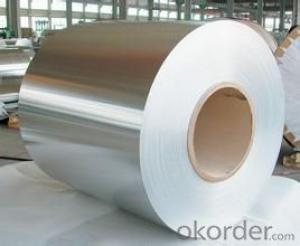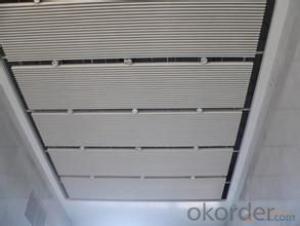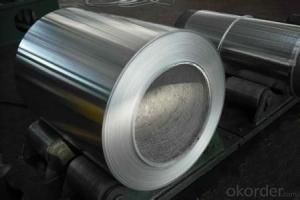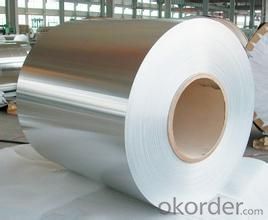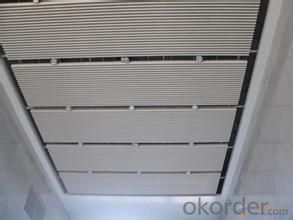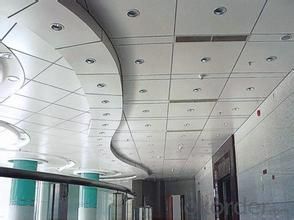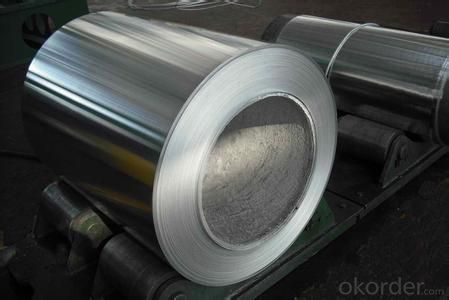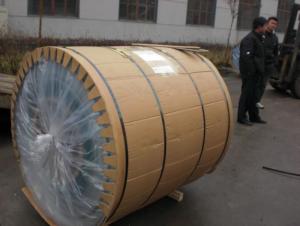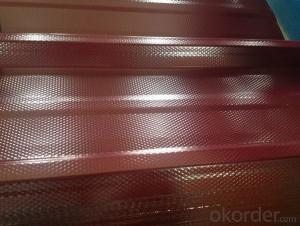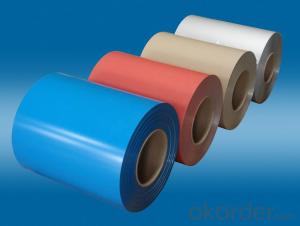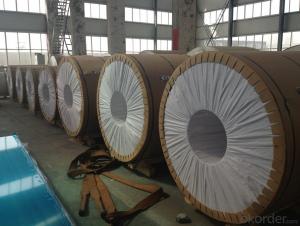Thin Aluminum Coil for Roofing
- Loading Port:
- China Main Port
- Payment Terms:
- TT OR LC
- Min Order Qty:
- -
- Supply Capability:
- -
OKorder Service Pledge
OKorder Financial Service
You Might Also Like
Aluminium is a relatively soft, durable, lightweight, ductileand malleablemetalwith appearance ranging from silvery to dull gray, depending on the surfaceroughness. It is nonmagnetic and does not easily ignite. A fresh film ofaluminium serves as a good reflector (approximately 92%) of visible lightand an excellent reflector (as much as 98%) of medium and far infraredradiation. The yield strength of pure aluminium is 7–11 MPa,while aluminium alloys have yield strengths ranging from200 MPa to 600 MPa. Aluminium has about one-third the densityand stiffness of steel. It is easily machined,cast, drawn and extruded.
Aluminium alloys (or aluminum alloys; see spellingdifferences) are alloysin which aluminium(Al) is the predominant metal. The typical alloying elements are copper, magnesium,manganese,silicon,tin and zinc. There are twoprincipal classifications, namely casting alloys and wrought alloys, both of which are furthersubdivided into the categories heat-treatableand non-heat-treatable. About 85% of aluminium is used for wrought products,for example rolled plate, foils and extrusions.Cast aluminium alloys yield cost-effective products due to the low meltingpoint, although they generally have lower tensile strengthsthan wrought alloys. The most important cast aluminium alloy system is Al–Si,where the high levels of silicon (4.0–13%) contribute to give good castingcharacteristics. Aluminium alloys are widely used in engineering structures andcomponents where light weight or corrosion resistance is required
Specification:
Alloy: AA1050, 1060, 1100,AA3003, 3005, 3015, 5052, 5754, 5083,8011, etc
Temper:H14/16/18/22/24/32, HO etc.
Thickness:0.2mm—100mm
Width: 100mm—2300mm (Can be slitted)
InnerDiameter: 508MM
Coil Weight:500kg-3000kg(Max.)
Application:Foil stock, Circles, Roofing, Can stock, Marine plate,Anti-slipery purpose in vehicles, packing and appliance.
Features:
1. Excellent quality of products
2. Quick delivery
3. Best service to clients
4. BV,SGS avalible
5. No buckle o waveness
6. Tension leveling
7. Certificate of Origin
8. Form A,E
Packaging Detail:
Carton ,Woodenpallet with plastic protection packing ,standard seaworthy packing or as yourrequest.
ProductionCapacity:
AnnualProduction capacity of 600,000 tons.
Products areexported to United States, Canada, U.A.E, Brazil, Mexico,Thailand, Vietnam,Nigeria etc, over 100 countries andregions all over the world.
Production Line:
CNBM aluminumproduction base is comprised of 18 aluminumannealers, 10 coil and foilmills, 4 continuous production lines, 2hot rolling production line and 3prepainted lines.
FAQ:
1. What is the form of payment?
Normally 30% TT, L/C
2. Type of quotation?
FOB, CFR, CIF
3. Port of loading?
Shanghai port
4. Delivery time?
30 day after client’s deposit
- Q: Is it possible to create baskets or containers using aluminum coils?
- <p>Yes, aluminum coils can be used to make baskets or containers. Aluminum is a lightweight, durable, and malleable material that can be easily shaped and bent into various forms. It is commonly used in manufacturing due to its strength and resistance to corrosion. For baskets or containers, aluminum coils can be woven or molded into the desired shape, offering both functionality and aesthetic appeal. However, it's important to consider the thickness and gauge of the aluminum to ensure the structure's stability and durability for its intended use.</p>
- Q: This question asks for methods to determine the age of an aluminum coil, distinguishing between new and old.
- <p>To determine if an aluminum coil is new or old, you can look for several indicators: the surface condition, such as scratches or signs of wear; the quality of the protective coating, if any, which may degrade over time; the manufacturing date or batch number, if available; and the overall appearance and shine. New coils typically have a smooth, shiny surface with no significant scratches or dents, and a consistent protective coating. Old coils may show signs of oxidation, discoloration, or other forms of degradation. Additionally, testing the coil's physical properties, such as tensile strength, can provide clues about its age, as these properties can degrade over time.</p>
- Q: How are aluminum coils used in the production of heat exchangers?
- The production of heat exchangers heavily relies on aluminum coils, which have a crucial role in the process. Heat exchangers, devices utilized for transferring heat between multiple fluids, are capable of efficiently heating or cooling in diverse applications. The primary reason for employing aluminum coils in heat exchanger production is the distinct properties possessed by aluminum. First and foremost, aluminum serves as an exceptional heat conductor. It exhibits high thermal conductivity, enabling effective heat transfer from one fluid to another. This characteristic plays a pivotal role in heat exchangers, guaranteeing swift and efficient heat exchange. Secondly, aluminum is both lightweight and boasts a high strength-to-weight ratio. Consequently, it is an ideal choice for heat exchangers, facilitating the creation of compact and lightweight units that can be effortlessly installed in various systems. The lightweight nature of aluminum coils also reduces the overall weight of the heat exchanger, which proves advantageous in weight-sensitive applications such as the automotive or aerospace industries. In addition, aluminum coils possess outstanding resistance to corrosion. Aluminum naturally forms a thin oxide layer on its surface, thus safeguarding it from corrosion. This resistance is critical in heat exchangers, which frequently come into contact with diverse and potentially corrosive fluids. By employing aluminum coils, the longevity and durability of the heat exchanger are ensured, averting premature failure or damage. Moreover, aluminum coils are highly malleable, allowing for easy shaping into various sizes and forms. This manufacturing flexibility enables the production of customized heat exchangers tailored to specific applications and requirements. The ability to shape aluminum coils also facilitates the design of intricate heat exchanger geometries, optimizing the heat transfer surface area and enhancing overall performance. To summarize, aluminum coils are extensively utilized in heat exchanger production due to their high thermal conductivity, lightweight nature, corrosion resistance, and malleability. These properties make aluminum an ideal material for efficient heat transfer, compact designs, durability, and customization. Altogether, aluminum coils contribute significantly to the efficacy and reliability of heat exchangers in diverse industries and applications.
- Q: This question asks for the distinctions between two forms of aluminum used in various industries: coils and sheets.
- <p>Aluminum coil and aluminum sheet are both flat aluminum products but differ in form and usage. Aluminum coil is a long, continuous roll of aluminum that can be easily cut to length and is often used for manufacturing processes like stamping, bending, and forming. It's ideal for applications requiring a consistent and uniform supply of material. On the other hand, aluminum sheet is a flat, rectangular piece of aluminum with a specific thickness, width, and length. It is used for applications where a single piece of material is needed, such as in construction, signage, and decorative purposes. The main difference lies in the form factor and the way they are used in manufacturing and construction processes.</p>
- Q: How are aluminum coils used in the production of cookware?
- The unique properties and versatility of aluminum coils make them crucial in the production of cookware. Various types of cookware, including pots, pans, and baking sheets, rely on these coils as their primary material. To begin with, aluminum coils are renowned for their exceptional heat conductivity. This allows for efficient and even distribution of heat throughout the cookware, ensuring that food is cooked evenly. It also minimizes the occurrence of hot spots or uneven cooking, which is essential for achieving optimal cooking results and preventing food from burning or sticking. Additionally, aluminum coils possess the advantage of being lightweight yet durable. This makes them ideal for cookware production as their lightweight nature makes the cookware easy to handle and maneuver while cooking. Consequently, the risk of accidents or injuries is reduced. Moreover, aluminum's durability guarantees that the cookware can endure high temperatures, constant use, and the demands of everyday cooking without warping or deforming. Furthermore, aluminum coils exhibit high resistance to corrosion and rust, making them suitable for cookware that comes into contact with food and liquids. This property ensures that the cookware remains hygienic and safe for cooking purposes, as aluminum does not react with acidic or alkaline ingredients commonly used in cooking. Moreover, aluminum coils are malleable and can be shaped into various cookware designs, including pots, pans, and bakeware with different sizes, shapes, and depths. This flexibility allows for the production of cookware that caters to different cooking techniques and preferences. Regarding production, aluminum coils undergo a series of manufacturing processes, such as rolling, annealing, and stamping, to transform them into the desired cookware shape. These processes guarantee that the final cookware product meets the necessary specifications in terms of thickness, strength, and appearance. In conclusion, the excellent heat conductivity, lightweight yet durable nature, resistance to corrosion, and malleability of aluminum coils make them essential in cookware production. They contribute significantly to the functionality and performance of cookware, providing efficient and even cooking results, durability, and ease of use. Consequently, aluminum coils are widely favored in the cookware industry.
- Q: What are the surface treatment options for aluminum coils?
- There are multiple choices when it comes to surface treatments for aluminum coils, depending on specific needs and desired outcomes. Some commonly used options are as follows: 1. Anodizing: This widely utilized method involves the creation of a protective oxide layer on the surface of the aluminum coil. Anodizing offers corrosion resistance, improved durability, and the ability to customize colors with dyes. 2. Painting: Various types of paint can be applied to aluminum coils to enhance their appearance, provide extra protection against corrosion, and increase resistance to UV radiation. Both liquid and powder coatings are available, offering different finishes and levels of durability. 3. Coil coating: This treatment is a continuous process where a coating material is applied to the surface of the aluminum coil. The coil is then cured, resulting in a uniform and long-lasting coating. This option provides a wide range of finishes, colors, and special effects. 4. Laminating: By applying a protective film or sheet onto the aluminum coil's surface, laminating can enhance its resistance to scratches, abrasion, and chemicals. This treatment is commonly used in applications where the coil may encounter harsh environments. 5. Brushing or polishing: These mechanical treatments can give the aluminum coil the desired texture, such as a brushed or mirror-like finish. Brushing creates parallel lines, while polishing results in a highly reflective and smooth surface. 6. Chemical conversion coatings: Typically used as a pre-treatment before painting or as a standalone treatment, these coatings enhance corrosion resistance and provide a base for subsequent coatings like paint or powder coating. These examples demonstrate the range of surface treatment options available for aluminum coils. The choice of treatment will depend on factors such as desired appearance, level of corrosion resistance, durability, and specific application requirements.
- Q: Is it safe and practical to use aluminum coil in cooking processes?
- <p>Aluminum coil can be used for cooking, but it's important to consider the specific type and context. Aluminum foil, for example, is commonly used for cooking in various forms such as wrapping food for baking or grilling, or lining baking sheets to prevent sticking. However, aluminum cookware is less common due to concerns about aluminum's potential health effects and its reactivity with certain foods. When using aluminum coil for cooking, ensure it's food-grade and avoid using it with acidic or alkaline foods, as this can lead to leaching of aluminum into the food. Always check the manufacturer's guidelines for safe use.</p>
- Q: How are aluminum coils used in packaging?
- Aluminum coils are widely used in packaging due to their excellent properties and versatility. These coils are usually made from aluminum alloy, known for its lightweight yet strong characteristics. One common application of aluminum coils in packaging is in the production of aluminum cans. The coils are rolled into thin sheets, which are then formed into cans of various shapes and sizes. The lightweight nature of aluminum makes it ideal for manufacturing cans that are easy to transport and handle, reducing overall packaging weight. Aluminum coils are also used in the production of flexible packaging materials such as foils and laminates. These materials are commonly used for packaging food products, pharmaceuticals, and other perishable goods. The flexibility of aluminum allows it to be easily shaped and formed into different packaging formats, ensuring efficient and convenient use. Another important use of aluminum coils in packaging is in the production of closures and bottle caps. Aluminum closures provide an airtight seal, protecting the contents of the package from external factors such as moisture, contaminants, or oxidation. Additionally, aluminum closures can be easily opened and closed, providing convenience to consumers. Furthermore, aluminum coils are employed in the production of blister packs, which are widely used in the pharmaceutical industry. Blister packs consist of a plastic sheet with aluminum foil lamination, creating a barrier against moisture, light, and oxygen. This packaging format ensures the integrity and safety of pharmaceutical products by protecting them from degradation or contamination. In summary, aluminum coils are extensively used in packaging due to their lightweight, strength, and versatility. These coils are transformed into various packaging formats such as cans, flexible foils, closures, and blister packs, providing durability, protection, and convenience to both manufacturers and consumers.
- Q: How are aluminum coils coated or treated for specific applications?
- Aluminum coils are coated or treated in various ways to cater to specific applications. One common method is the application of a protective coating, such as a polymer or paint, to enhance durability and resist corrosion. This coating is typically applied through a process called coil coating, where a thin layer of coating material is evenly spread on the surface of the aluminum coil. The coil coating process involves several steps. First, the aluminum coil is cleaned to remove any impurities or contaminants. This step is crucial as it ensures proper adhesion of the coating to the metal surface. After cleaning, the coil is treated with a chemical pre-treatment to enhance the bonding between the aluminum and the coating material. Once the pre-treatment is completed, the coil is fed through a coating machine where the coating material is applied. The coating material can be a liquid paint, a powder coating, or even a thin film. The choice of coating material depends on the specific application requirements, such as desired appearance, durability, or chemical resistance. After the coating is applied, the coil goes through a curing process, which can involve baking the coil at high temperatures or exposing it to ultraviolet light. This curing process ensures that the coating material properly adheres to the aluminum surface, providing excellent protection and longevity. In addition to protective coatings, aluminum coils can also undergo other treatments for specific applications. For instance, they can be anodized, a process that creates a thick, durable oxide layer on the surface of the aluminum. Anodizing enhances corrosion resistance, improves aesthetics, and can also provide a base for further coatings or treatments. Furthermore, aluminum coils can be laminated with other materials for specific applications. For example, they can be laminated with plastic films or adhesive coatings to provide insulation, moisture resistance, or other special properties. In summary, aluminum coils are coated or treated for specific applications by applying protective coatings, such as polymer or paint, through processes like coil coating. Additional treatments like anodizing or lamination with other materials may also be employed depending on the desired properties and requirements of the application.
- Q: The user is asking if it's possible to purchase recycled aluminum coil through online platforms.
- <p>Yes, you can buy recycled aluminum coil online. Many online marketplaces and specialized metal supply websites offer a variety of aluminum coils, including recycled ones. You can search for suppliers on platforms like Alibaba, Amazon, or industry-specific B2B websites. Be sure to check the supplier's reputation, the quality of the recycled aluminum, and the specifications to ensure it meets your requirements.</p>
Send your message to us
Thin Aluminum Coil for Roofing
- Loading Port:
- China Main Port
- Payment Terms:
- TT OR LC
- Min Order Qty:
- -
- Supply Capability:
- -
OKorder Service Pledge
OKorder Financial Service
Similar products
Hot products
Hot Searches
Related keywords
